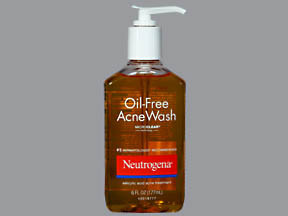SALICYLIC ACID (FOR ACNE) - TOPICAL
PHONETIC PRONUNCIATION: (SAL-i-SIL-ik AS-id)
GENERIC NAME(S): salicylic acid
Uses
USES: This product is used to treat mild to moderate acne. It may be used in combination with other acne treatments. Check with your doctor or pharmacist first before combining acne treatments. Salicylic acid belongs to a class of drugs known as salicylates. When applied to the skin, salicylic acid may work by helping the skin to shed dead cells from the top layer and by decreasing redness and swelling (inflammation). This decreases the number of pimples that form and speeds healing.
How to use SALICYLIC ACID (FOR ACNE) - TOPICAL
HOW TO USE: Follow all directions on the product package. If you are uncertain about any of the information, consult your doctor or pharmacist. Before using this product for the first time, check if you are allergic to it. To check, put a small amount on one or two small areas of acne for three days. If you have an allergic reaction, stop using this product and get medical help right away (see the symptoms of an allergic reaction in the Side Effects section). If you don't have an allergic reaction, you can use the product. This medication is for use on the skin only. To avoid irritation, do not let this medication come into contact with your eyes, nose, mouth, groin, or any broken skin (e.g., cuts, scrapes, rashes). If you do get the medication in those areas, flush the area with cool water for 15 minutes. If you are using a cream, lotion, solution, or gel, apply a thin film of the medication to the areas of your skin affected by acne, usually 1 to 2 times a day or as directed by your doctor. Before applying each dose, gently wash the affected area with a mild cleanser, then pat dry. Apply a small amount of medicine to the affected area and rub in gently. If using the pads, wash the affected skin with a mild cleanser, then pat dry. Wipe the pad gently onto the skin to apply the medication, usually 1 to 3 times a day or as directed by your doctor. Wash hands after use. If using cleansers containing salicylic acid, wet the affected area. Gently rub the cleanser into the skin for 10 to 20 seconds. Do not scrub the skin. Work into a full lather and rinse thoroughly, and then pat dry. If too much drying occurs, you may need to rinse the cleanser off sooner or use it less often. Consult your doctor or pharmacist for further details. Dosage is based on your medical condition and response to treatment. Do not use large amounts, apply this drug more often, or use it for a longer period than directed. Your condition will not clear faster, but the chance for side effects may be increased. If your condition persists or worsens, or if you think you may have a serious medical problem, seek immediate medical attention.
Side Effects
Precautions
Interactions
Overdose
Images
Reviews
Faq for SALICYLIC ACID (FOR ACNE) - TOPICAL
Salicylic acid is a beta-hydroxy acid that helps to treat acne by exfoliating the skin and removing dead skin cells. It penetrates the skin and unclogs pores, preventing the formation of pimples, blackheads, and whiteheads.
You should cleanse your face with a mild cleanser and pat it dry before applying salicylic acid. Follow the instructions provided by your healthcare professional or the medication label. Generally, apply a thin layer of the product on the affected areas, avoiding contact with eyes and lips. It is typically recommended to use salicylic acid once or twice daily.
Yes, salicylic acid may cause skin irritation, especially if used excessively or if you have sensitive skin. Common side effects include redness, dryness, peeling, and slight burning or stinging sensation. However, these side effects usually subside after regular use.
It is generally safe to use salicylic acid alongside other acne treatments like benzoyl peroxide or topical antibiotics. However, it is advisable to consult a healthcare professional or pharmacist before combining different topical acne medications.
Salicylic acid is most effective for treating non-inflammatory acne, such as blackheads and whiteheads. It may also help with mild inflammatory acne, but it may not be as effective for severe or cystic acne. In such cases, you should consult a dermatologist for appropriate treatment options.
Salicylic acid is not a quick-fix solution for acne. It usually takes several weeks of consistent use to see noticeable improvements in your skin. Be patient and continue using it as directed even if you don't see immediate results.
It is generally considered safe to use salicylic acid topically during pregnancy and breastfeeding. However, it is always best to consult with your healthcare provider before using any medication or skincare product while pregnant or breastfeeding.
Disclaimer
IMPORTANT: HOW TO USE THIS INFORMATION: This is a summary and does NOT have all possible information about this product. This information does not assure that this product is safe, effective, or appropriate for you. This information is not individual medical advice and does not substitute for the advice of your health care professional. Always ask your health care professional for complete information about this product and your specific health needs.

No Reviews Yet